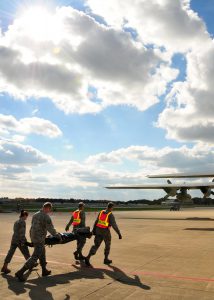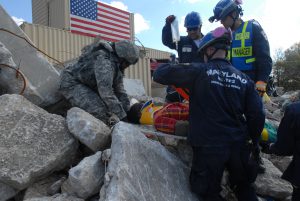Always Ready, Always Relevant – Vigilant Maryland Guard
[vc_row][vc_column][vc_video link=”https://www.youtube.com/watch?v=T5pg_B9L4O4″ align=”center”][vc_column_text css=”.vc_custom_1500311675568{margin: 0px !important;border-width: 0px !important;padding: 0px !important;}”]
Spc. Crystal Hudson, 29th Mobile Public Affairs Detachment
[/vc_column_text][vc_column_text css_animation=”fadeIn”]
 The Maryland National Guard’s 32nd Civil Support Team (Weapons of Mass Destruction), based out of Fort George G. Meade, Md., took part in Vigilant Guard Nov. 5-7, 2010, in Baltimore. Vigilant Guard is a multi-agency exercise that focuses on building relationships between the National Guard and local first responders. The scenario tested the unit’s response to a simulated explosion at a chemical production facility.
The Maryland National Guard’s 32nd Civil Support Team (Weapons of Mass Destruction), based out of Fort George G. Meade, Md., took part in Vigilant Guard Nov. 5-7, 2010, in Baltimore. Vigilant Guard is a multi-agency exercise that focuses on building relationships between the National Guard and local first responders. The scenario tested the unit’s response to a simulated explosion at a chemical production facility.
The CST can detect and analyze possible chemical threats; something that is vital should a real-world incident, such as a chemical plant explosion, take place. An exercise like Vigilant Guard allows them to stay ready.
“This exercise validates all the training of the Soldiers and Airmen in this team,” said Army Maj. Andrew Collins, deputy commander of the 32nd CST. “Each person on the team is a subject matter expert.”
Exercises, such as Vigilant Guard, allow the unit to hone their skills to get ready for real-world emergencies.
Such an incident happened in July 2010 when a suspicious envelope containing a white powder substance was dropped off at the Fort Meade police station. The team was called out to assess the risk of the powder, said Collins. They tested the suspicious powder and determined that it was not a threat.
Vigilant Guard is only one way the team stays prepared, said Collins, adding that the team is usually part of a collective training exercise each month to prepare for possible incidents of terrorism, natural disasters and situations where toxic materials may be released.
That training allows the unit the ability to effectively communicate and react in times of crisis.
“Communication is key in this situation,” said Army 1st Lt. Michael Kehs, survey team leader with the 32nd CST. “We need to detect and identify the radiological hazards at the scene… keep[ing] contact with one another at least every five minutes.”
Once the threat level is determined, the CST has a communications platform in their command vehicle with the ability to securely transmit classified information.
This allows them the ability to stay in contact with officials from multiple agencies, said team members. The unit’s capabilities are designed to augment and supplement local hazardous materials response teams, rather than replace them.
During Vigilant Guard, the Maryland-based CST received support from CSTs in neighboring states, something that may happen should a real-world scenario take place.
That is a benefit of taking part in the exercise, said Collins. “…staying ready and building those bridges, should they be needed.
[/vc_column_text][/vc_column][/vc_row][vc_row][vc_column][vc_raw_html]JTNDYSUyMGRhdGEtZmxpY2tyLWVtYmVkJTNEJTIydHJ1ZSUyMiUyMGRhdGEtaGVhZGVyJTNEJTIydHJ1ZSUyMiUyMCUyMGhyZWYlM0QlMjJodHRwcyUzQSUyRiUyRnd3dy5mbGlja3IuY29tJTJGcGhvdG9zJTJGbWRuZyUyRmFsYnVtcyUyRjcyMTU3NjI1MzMwNjY1NzIyJTIyJTIwdGl0bGUlM0QlMjJWaWdpbGFudCUyMEd1YXJkJTIyJTNFJTNDaW1nJTIwc3JjJTNEJTIyaHR0cHMlM0ElMkYlMkZmYXJtMi5zdGF0aWNmbGlja3IuY29tJTJGMTQwMiUyRjUxNTQyNTAyMzJfMjE5NGI4ODI4MF9iLmpwZyUyMiUyMHdpZHRoJTNEJTIyMTAyNCUyMiUyMGhlaWdodCUzRCUyMjY4NSUyMiUyMGFsdCUzRCUyMlZpZ2lsYW50JTIwR3VhcmQlMjIlM0UlM0MlMkZhJTNFJTNDc2NyaXB0JTIwYXN5bmMlMjBzcmMlM0QlMjIlMkYlMkZlbWJlZHIuZmxpY2tyLmNvbSUyRmFzc2V0cyUyRmNsaWVudC1jb2RlLmpzJTIyJTIwY2hhcnNldCUzRCUyMnV0Zi04JTIyJTNFJTNDJTJGc2NyaXB0JTNF[/vc_raw_html][/vc_column][/vc_row]
